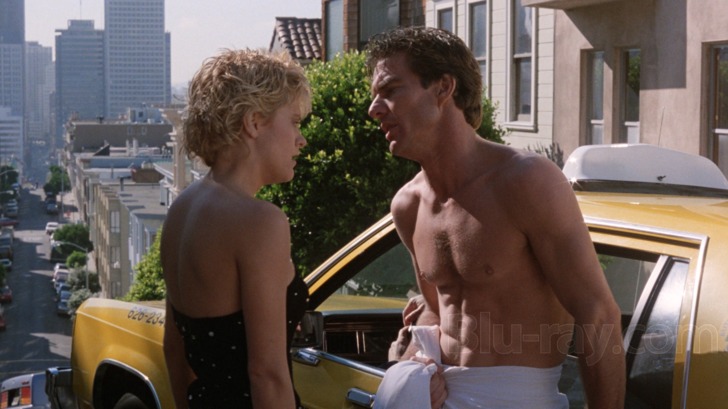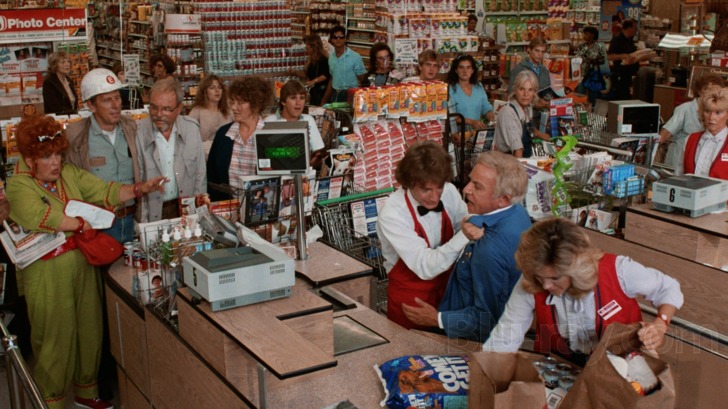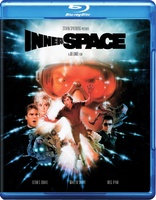Innerspace Blu-ray Movie
HomeInnerspace Blu-ray Movie 
Warner Bros. | 1987 | 120 min | Rated PG | Aug 04, 2015Movie rating
7.2 | / 10 |
Blu-ray rating
| Users | 0.0 | |
| Reviewer | 4.0 | |
| Overall | 4.0 |
Overview
Innerspace (1987)
Test pilot Tuck Pendleton volunteers to test a special vessel for a miniaturization experiment. Accidentally injected into a neurotic hypochondriac, Jack Putter, Tuck must convince Jack to find his ex-girlfriend, Lydia Maxwell, to help him extract Tuck and his ship and re-enlarge them before his oxygen runs out.
Starring: Dennis Quaid, Martin Short, Meg Ryan, Kevin McCarthy, Fiona LewisDirector: Joe Dante
| Sci-Fi | Uncertain |
| Comedy | Uncertain |
| Adventure | Uncertain |
Specifications
Video
Video codec: MPEG-4 AVC
Video resolution: 1080p
Aspect ratio: 1.78:1
Original aspect ratio: 1.85:1
Audio
English: DTS-HD Master Audio 5.1 (48kHz, 24-bit)
French: Dolby Digital 2.0
Spanish: Dolby Digital 2.0
Portuguese: Dolby Digital Mono
Thai: Dolby Digital 2.0
Japanese: Dolby Digital 2.0
Spanish=Latin & Castillian; Japanese is hidden
Subtitles
English SDH, French, Japanese, Portuguese, Spanish, Danish, Finnish, Korean, Mandarin (Traditional), Norwegian, Swedish, Thai
Discs
50GB Blu-ray Disc
Single disc (1 BD)
Playback
Region free
Review
Rating summary
| Movie | 4.5 | |
| Video | 4.5 | |
| Audio | 4.0 | |
| Extras | 2.5 | |
| Overall | 4.0 |
Innerspace Blu-ray Movie Review
The Voyage of Tuck and Jack
Reviewed by Michael Reuben August 1, 2015If Innerspace hadn't ended up with director Joe Dante under the protective wing of Steven Spielberg's Amblin Entertainment, it might have turned out as a sci-fi movie, the Eighties equivalent of Fantastic Voyage, instead of the comedy classic it became. Even so, many contemporary viewers mistook it for science fiction. The film won an Oscar for Industrial Light and Magic's impressive miniatures depicting a tiny one-man "pod" navigating the rough interiors of the human body. New Yorker critic Pauline Kael, a Dante fan, accused the director of selling out to mainstream tastes by making a movie with "heart", but Innerspace only has as much "heart" as a Warner cartoon whenever the Roadrunner successfully evades Wile E. Coyote. Dante himself notes in the commentary previously recorded for Warner's 2002 DVD that Innerspace, too, is a cartoon—and that should become obvious by the point when one character's face is being transformed into another's by a process that resembles the TV-addicted alien's twitchings in the director's Explorers. The film's script spent a long time in development and bounced among several studios. The original story came from Chip Proser (Iceman), but much of the snappy dialogue was penned by the late Jeffrey Boam (Lethal Weapon 2 and 3, Indiana Jones and the Last Crusade). Further dialogue was improvised by the talented cast on the set or during reshoots, of which, according to the commentary, there were many, whenever Dante or Spielberg thought that a scene could be made better.

Innerspace mixes elements from romantic comedy, sci-fi, espionage and buddy movies, and Dante hops among them so nimbly that the blend is seamless. The romance is between Air Force Lt. Tuck Pendleton (Dennis Quaid), a charming hot shot with a big mouth and bad attitude, and investigative journalist Lydia Maxwell (Meg Ryan, in her first major role), who keeps trying to run away from Tuck and always gets pulled back. (Their favorite song, Sam Cooke's "Cupid", is both an aphrodisiac and a plot point.) The sci-fi is supplied by a Silicon Valley venture called Vectorscope, which has perfected the process of miniaturization and re-enlargement but needs a test pilot with no alternatives—i.e., Tuck—as a volunteer. Shrunk to near-microscopic size, Tuck will operate an ungainly "pod" designed to be injected into a live organism and piloted throughout the body for study and, eventually, treatment. The planned test subject is a rabbit nicknamed, naturally, "Bugs". Espionage enters the project, because Vectorscope is not the only outfit interested in shrinking things. An arms dealer and all-around bad guy named Victor Scrimshaw (Kevin McCarthy) wants to sell the process to the highest bidder, and his minions, led by rapacious (in more ways than one) scientist Dr. Margaret Canker (Fiona Lewis), raid Vectorscope's lab just as a miniaturized Tuck is about to be injected into Bugs. Narrowly escaping with the syringe containing Tuck in his tiny craft, the injured project head, Ozzie Wexler (Dante's former cinematographer John Hora, who was cast at Spielberg's suggestion), injects the unsuspecting test pilot into the first available person he encounters: a neurotic assistant manager at Safeway named Jack Putter (Martin Short), who has just been told by his doctor (William Schallert) that he needs complete rest with no excitement. And that's the buddy movie. After Tuck realizes that he's been injected into a person and makes contact through Jack's auditory nerves, and after Jack finally accepts that there's a tiny man traveling inside his body (he initially thinks he's possessed), the two become partners by necessity. Jack has become the target of Scrimshaw's men, and Tuck needs him to recover the chip they stole from Vectorscope, which contains essential code to re-enlarge him, before his miniaturized oxygen supply is exhausted. (The rest of the code is securely lodged in Tuck's ship.) They have to work together; they need Lydia's help; and they have to deal with a mysterious courier known only as "The Cowboy" (Robert Picardo, a regular in Dante's films). For the duration of their adventures, Tuck and Jack never share the screen, but Dennis Quaid and Martin Short create such a credible, if unlikely, relationship that their cooperation feels like the real thing—so real, in fact, that there's a nascent romantic triangle with Meg Ryan's Lydia. Joe Dante insisted on having Quaid and Short present for each other's scenes, so that the two could engage in a genuine dialogue, and the result is a spontaneity and mutual inspiration that can't be manufactured in the editing room. Quaid makes the most of the limited maneuvering room he has while strapped into a pilot's chair, but Short performs wildly physical moves in every possible direction, whether Jack is dancing to "Twisting the Night Away", straddling a freezer truck and a sports car during a high-speed chase or hyperventilating in his doctor's office. Meanwhile, ILM shows us Jack's heart, lungs, optic nerve, esophagus and stomach from Tuck's point of view, in just enough detail to be realistic without being (as effects wizard Dennis Muren says) too disgusting. Because this is a Joe Dante film, the cast is packed with cameos and familiar faces from film and TV. Warner animation legend Chuck Jones and veteran character actor Rance Howard (father of Ron) appear as Safeway customers, but they're easily overlooked because they're standing next to comedy legend Kathleen Freeman ("The Penguin" in The Blues Brothers), who plays the customer from Jack's nightmare. Martin Short's former SCTV teammates Joe Flaherty and Andrea Martin share a scene with him as fellow patients in his doctor's waiting room. Dante's "good luck charm", as the director calls him, Dick Miller, who appears in all his films, plays a cab driver picking up Lydia after she spends the night with Tuck. And the silent role of Mr. Igoe, chief henchman of Victor Scrimshow, is played by Australian tough guy Vernon Wells, famed worldwide as the fearsome Wez in The Road Warrior . For my money, Mr. Igoe's fate in Innerspace tops that of anything ever dished out by Mad Max.
Innerspace Blu-ray Movie, Video Quality 

Innerspace was shot by Hungarian cinematographer Andrew Lazlo, whose eclectic résumé extends from Walter Hill's Streets of Fire to Ted Kotcheff's First Blood. Warner's MPI has newly transferred the film for Blu-ray, with the results approved by Amblin Entertainment and director Joe Dante, who recently expressed his satisfaction with the new master at Comic Con. The resulting 1080p, AVC-encoded Blu-ray is truly impressive, especially when one considers the wide variety of locations, interiors and pre-digital, in-camera effects shots that have to be effectively reproduced to bring Innerspace to HD video. Detail and sharpness are impressive throughout, whether in closeups of characters in intense conversation or in long shots filled with people in objects (look at the crowd- and object-filled Safeway scene in screenshot 5 for an example). Even in the dingy and deliberately underlit environs of Vectorscope (which is supposed to look underfunded), all of the equipment, personnel and disorder are visible (see screenshots 8 and 11). By contrast, Scrimshaw's lab is hi-tech, overbright, inhumanly flourescent—but equally detailed (screenshot 27). The darkest scenes are those inside Tuck's cockpit, where deep blacks alternate with indirect illumination from view screens that glow in bright primary colors (screenshot 3) and the ILM miniatures depicting Jack's interiors, which were made deliberately dark to create a more realistic look than the effects of Fantastic Voyage (screenshots 4 and 14). Innerspace has been rendered with a visibly fine and natural grain pattern that shows no signs of artificial sharpening or filtering. It has also been placed on a BD-50 with an average bitrate of 26.91 Mbps, which is significantly above the range for which Warner has aimed in the past for catalog titles. Both the disc size and the bitrate suggest that the changes in approach that have long been rumored at Warner are finally taking hold. If the treatment given Innerspace is any indication, the future looks promising.
Innerspace Blu-ray Movie, Audio Quality 

Innerspace was released in Dolby Surround for 35mm, but there was also a 6-track mix for a 70mm blow-up. It is unclear whether the 5.1 Dolby Digital track on Warner's 2002 DVD was based on the 6-track mix or the individual stems for the surround mix. In any case, the DVD's 5.1 mix appears to be the same one offered on Blu-ray, but now encoded in lossless DTS-HD MA. The most aggressive use of the surrounds in Innerspace involves Tuck Pendleton's "pod" adventures, beginning with his miniaturization in a huge centrifuge and continuing throughout his organic voyage. The sound designers immerse the viewer, as Tuck is immersed (literally), in circulating blood, rushing air, gastric juices and even Southern Comfort raining down the esophagus as Jack takes a drink. From Tuck's point of view, Jack's heart thumps intently. In the exterior scenes, the sound mix is more front-oriented, except in the occasionally loud environment like Inferno, the club where Lydia and Jack meet the Cowboy, or the shopping mall where Ozzie tries to hide from Mr. Igoe. Dialogue is clear and well-balanced throughout, which is especially important in the exchanges between Jack and Tuck, where Dennis Quaid's lines have to be reduced in volume and dynamic range, so that they sound like a good telephone connection. Innerspace benefits from a great score by the late Jerry Goldsmith, whom Dante praised for striking a perfect balance between drama and comedy. The orchestral performance plays with the best fidelity I have heard in any version of the film released to date. A potential mastering problem in the soundtrack for Innerspace has been identified by a Blu-ray.com member who received an early screener. The member reported a persistent crackling distortion occurring every five to six minutes throughout the film and lasting for several minutes at a time. When I was unable to reproduce the effect on my own review copy, we exchanged further technical information, and it appears that the issue is limited to Sony Blu-ray players (specifically, a PS3, PS4 and BDP-S590), whereas my review player is a Panasonic BDP-50. Additional factors may also come into play (e.g., firmware or receiver models), but for now all I can do is alert readers to the possibility and direct them to the Blu-ray.com forum for further information as more users gain experience with this title.
Innerspace Blu-ray Movie, Special Features and Extras 

The extras have been ported over from Warner's 2002 DVD of Innerspace.
- Commentary with Director Joe Dante, Producer Michael Finnell, Effects Supervisor Dennis Muren and Actors Kevin McCarthy and Robert Picardo: Dante and Finnell dominate the discussion, with Muren chiming in whenever he is invited to discuss specific effects shots. McCarthy, who was in his late 80s at the time (and has since passed awaw), offers a few humorous remarks on his own scenes, and Picardo does not join the group until halfway through the film. Between them, Dante and Finnell have remarkable recall for details of the project's development and production, including what was initially scripted, what was ad libbed and what had to be reshot. Muren's description of how the effects were achieved is equally detailed, and his perspective, as one of the founders of the CGI revolution, on the pros and cons of old-fashioned miniatures, is insightful and informative.
- Theatrical Trailer (480; 1.78:1, enhanced; 1:30): "Now Jack's got twice the problems, but he's twice the man."
Innerspace Blu-ray Movie, Overall Score and Recommendation 

Innerspace's technology looks clunky and inefficient, but it always did. (The mechanical arm for inserting the miniaturization chip is so loopy that it becomes a running joke.) For just that reason, the film hasn't dated. The techno-babble that John Hora's Ozzie speaks for the video record while Tuck prepares to be miniaturized sounds just as convincingly nonsensical today as when the movie premiered in 1987 (and you can hear it a lot better now with the Blu-ray's lossless audio). Everything else in the film—the love story, the inspired physical comedy, the cartoonish bad guys and their well-deserved fates—is timeless. Leaving aside the audio glitch, which will hopefully be either minor or easily addressed, Warner has produced a Blu-ray version of Innerspace that was worth the wait and is highly recommended.
Similar titles
Similar titles you might also like

Spaceballs 4K
1987

The Hitchhiker's Guide to the Galaxy
2005

Paul
Unrated + Theatrical
2011

Lazer Team
2015

Red Dwarf X
2012

Red Dwarf XI: The Complete Eleventh Series
2016

Red Dwarf: Back to Earth
The Director's Cut
2009

Galaxy Quest 4K
25th Anniversary
1999

Red Dwarf XII
2017

The Hitchhiker's Guide to the Galaxy
Anniversary Edition
1981

Red Dwarf: The Promised Land
2020

Star Trek: Lower Decks: The Final Season
2024

Angry Video Game Nerd: The Movie
2014

Land of the Lost
2009

Galaxina
1980

Back to the Future: Doc Brown Saves the World
2015

Flash Gordon
1980

Family Guy: Blue Harvest
2007

Back to the Future Part II 4K
1989

Airplane II: The Sequel 4K
1982
